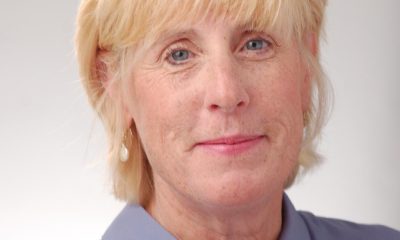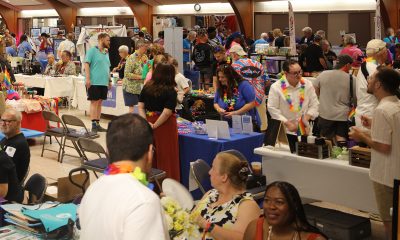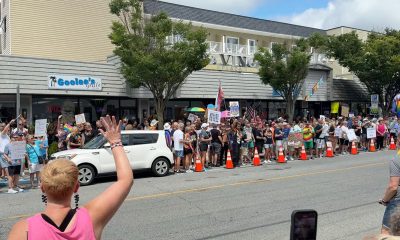Books
Provocative pages
LGBT authors celebrate the written word at this weekend’s OutWrite

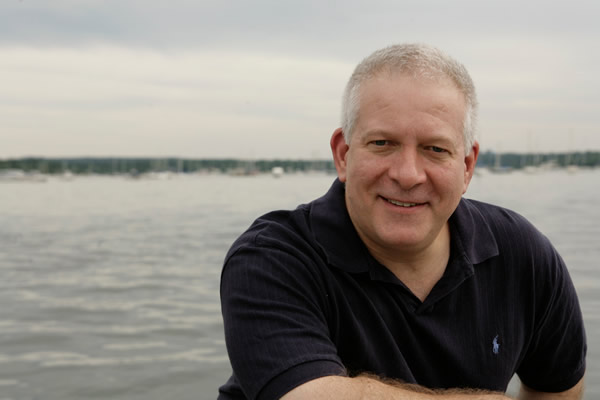
Gay author William Sterling Walker will present his New Orleans-themed short story collection at the OutWrite Book Fair Saturday at 11 a.m. (Photo by Lenora Gim)
OutWrite
LGBT Book Fair
Today through Sunday
Starts Friday evening at 6:30 p.m.
D.C. Center for the LGBT Community
1318 U Street, N.W.
‘Women Write Gay Erotica’
Continues Saturday at the Reeves Center
2000 14th Street, N.W.
Ends Sunday with events starting at 10 a.m.
At the D.C. Center
Visit thedccenter.org for full schedule and details
It would be a mistake to assume that all the authors appearing at this year’s OutWrite LGBT Book Fair are small-time writers who’ve all self-published their work.
Novelist Manil Suri, who will be presenting his adventure novel “The City of Devi,” had his first book “The Death of Vishnu” become a bestseller in several countries that has been translated into 27 languages. Poet Joseph Ross — like Suri, a teacher/professor — had his books published by Main Street Rag Publishing based in Charlotte, N.C., and even though William Sterling Walker’s short story collection “Desire: Tales of New Orleans,” is his first book, it was published by Chelsea Station Editions (which will exhibit at this year’s fair) and his stories have appeared in several magazines and anthologies.
“We got a lot of submissions from folks who want to come read so it’s actually become quite competitive,” says David Mariner, director of the DC Center, which produces the fair, now in its third year. “We were lucky to have [lesbian writer] Julie Enszer on the planning committee this year and she was … very valuable in the process.”
Mariner says in previous years the readings typically attract 30 or 40 people at any given time with a “couple hundred” visiting the fair altogether. It kicks off tonight and runs through Sunday. Saturday the events will be in the atrium at the Reeves Building. Tonight and Sunday, readings will take place at the Center’s current location on U Street. Mariner says the events will not be affected by last week’s announcement about changes to the Reeves Building’s fate, where the Center had been planning to move permanently.
Mariner says “the majority” of this year’s authors have had their work published by traditional publishers but he says that’s less a significant distinction than it may have been several years ago as the industry is changing rapidly.
“It’s a little harder to say now who meets that criteria because the lines have really blurred,” Mariner says. “In fact, that’s one discussion we’re going to have at the fair.”
Ross has been writing poetry since college about 20 years ago. The D.C. resident says his poetry book “Gospel of Dust,” which came out in July, touches on everything from the notion of various riots being somewhat ritualistic in nature and the sometimes unexpected places religious elements are found in everyday life such as in the lives of people like Rosa Parks or Matthew Shepard and even in the work of local graffiti artists.
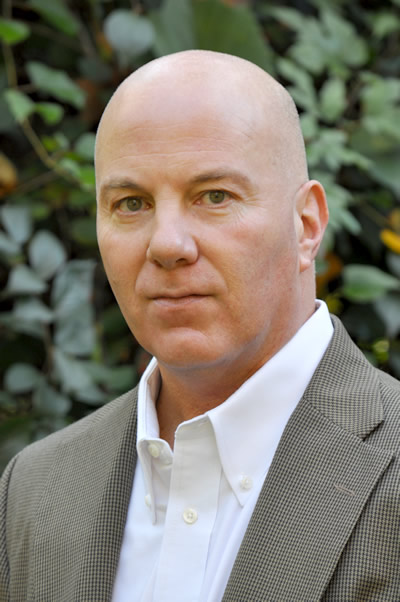
Joseph Ross will read from his poetry collection at 3 p.m. (Ross photo by Ted Schroll)
“Poetry has the power to move us both emotionally and intellectually,” Ross says. “No one says, ‘Would you read an essay at our wedding?’ It’s there in our important moments — births, deaths, marriages, people turn to poetry. It’s not above anything else, but it moves us in ways other genres can’t.”
Suri’s latest book, which came out in February from Bloomsbury, tells an adventure story of a woman searching Bombay/Mumbai (Suri’s native land where all his books are set) for her missing husband with — unbeknownst to her — a gay guy who had been her husband’s lover. Suri says the book, which he spent about 12 years working on off and on, offers a snapshot look at gay life in India.
“You see some of that in the characters,” he says. “Initially it was very oriented toward anonymous sex and been sort of 10 or 20 years behind the U.S. but now you see more liberal attitudes and people are thinking about settling down and having relationships and … you see how people treat Jaz and Karun as a couple even though they don’t know they’re together explicitly.”
Walker says the nine short stories in his book “Desire: Tales of New Orleans” all pertain to the title city in some way and have gay themes.
“I’m gay and I have always considered myself as having a gay audience,” he says. “I’ve always felt that way. I consider myself a gay writer with gay sensibilities.”
He says it’s important for gay writers to have spaces such as the OutWrite festival.
“There are very few venues left for gay books,” he says. “There are very few gay bookstores left and other independent bookstores are going away too. … I think it’s very important for writers and readers to connect and to do so on the face-to-face level and this is one way to do it.”
Mariner agrees.
“The overarching message of all of our arts programming is that it’s very powerful and moving and affirming when we hear our own stories through our own voices in our own spaces,” he says. “It’s a powerful and important part of building our community.”

This past year, you’ve often had to make do.
Saving money here, resources there, being inventive and innovative. It’s a talent you’ve honed, but isn’t it time to have the best? Yep, so grab these Ten Best of 2025 books for your new year pleasures.
Nonfiction
Health care is on everyone’s mind now, and “A Living: Working-Class Americans Talk to Their Doctor” by Michael D. Stein, M.D. (Melville House, $26.99) lets you peek into health care from the point of view of a doctor who treats “front-line workers” and those who experience poverty and homelessness. It’s shocking, an eye-opening book, a skinny, quick-to-read one that needs to be read now.
If you’ve been doing eldercare or caring for any loved one, then “How to Lose Your Mother: A Daughter’s Memoir” by Molly Jong-Fast (Viking, $28) needs to be in your plans for the coming year. It’s a memoir, but also a biography of Jong-Fast’s mother, Erica Jong, and the story of love, illness, and living through the chaos of serious disease with humor and grace. You’ll like this book especially if you were a fan of the author’s late mother.
Another memoir you can’t miss this year is “Between the Devil and the Deep Blue Sea: A Veteran’s Memoir” by Khadijah Queen (Legacy Lit, $30.00). It’s the story of one woman’s determination to get out of poverty and get an education, and to keep her head above water while she goes below water by joining the U.S. Navy. This is a story that will keep you glued to your seat, all the way through.
Self-improvement is something you might think about tackling in the new year, and “Replaceable You: Adventures in Human Anatomy” by Mary Roach (W.W. Norton & Company, $28.99) is a lighthearted – yet real and informative – look at the things inside and outside your body that can be replaced or changed. New nose job? Transplant, new dental work? Learn how you can become the Bionic Person in real life, and laugh while you’re doing it.
The science lover inside you will want to read “The Grave Robber: The Biggest Stolen Artifacts Case in FBI History and the Bureau’s Quest to Set Things Right” by Tim Carpenter (Harper Horizon, $29.99). A history lover will also want it, as will anyone with a craving for true crime, memoir, FBI procedural books, and travel books. It’s the story of a man who spent his life stealing objects from graves around the world, and an FBI agent’s obsession with securing the objects and returning them. It’s a fascinating read, with just a little bit of gruesome thrown in for fun.
Fiction
Speaking of a little bit of scariness, “Don’t Forget Me, Little Bessie” by James Lee Burke (Atlantic Monthly Press, $28) is the story of a girl named Bessie and her involvement with a cloven-hooved being who dogs her all her life. Set in still-wild south Texas, it’s a little bit western, part paranormal, and completely full of enjoyment.
“Evensong” by Stewart O’Nan (Atlantic Monthly Press, $28) is a layered novel of women’s friendships as they age together and support one another. The characters are warm and funny, there are a few times when your heart will sit in your throat, and you won’t be sorry you read it. It’s just plain irresistible.
If you need a dark tale for what’s left of a dark winter season, then “One of Us” by Dan Chaon (Henry Holt, $28), it it. It’s the story of twins who become orphaned when their Mama dies, ending up with a man who owns a traveling freak show, and who promises to care for them. But they can’t ever forget that a nefarious con man is looking for them; those kids can talk to one another without saying a word, and he’s going to make lots of money off them. This is a sharp, clever novel that fans of the “circus” genre shouldn’t miss.
“When the Harvest Comes” by Denne Michele Norris (Random House, $28) is a wonderful romance, a boy-meets-boy with a little spice and a lot of strife. Davis loves Everett but as their wedding day draws near, doubts begin to creep in. There’s homophobia on both sides of their families, and no small amount of racism. Beware that there’s some light explicitness in this book, but if you love a good love story, you’ll love this.
Another layered tale you’ll enjoy is “The Elements” by John Boyne (Henry Holt, $29.99), a twisty bunch of short stories that connect in a series of arcs that begin on an island near Dublin. It’s about love, death, revenge, and horror, a little like The Twilight Zone, but without the paranormal. You won’t want to put down, so be warned.
If you need more ideas, head to your local library or bookstore and ask the staff there for their favorite reads of 2025. They’ll fill your book bag and your new year with goodness.
Season’s readings!
The Blade may receive commissions from qualifying purchases made via this post.
Books
This gay author sees dead people

‘Are You There Spirit? It’s Me, Travis’
By Travis Holp
c.2025, Spiegel and Grau
$28/240 pages
Your dad sent you a penny the other day, minted in his birth year.
They say pennies from heaven are a sign of some sort, and that makes sense: You’ve been thinking about him a lot lately. Some might scoff, but the idea that a lost loved one is trying to tell you he’s OK is comforting. So read the new book, “Are You There, Spirit? It’s Me, Travis” by Travis Holp, and keep your eyes open.

Ever since he was a young boy growing up just outside Dayton, Ohio, Travis Holp wanted to be a writer. He also wanted to say that he was gay but his conservative parents believed his gayness was some sort of phase. That, and bullying made him hide who he was.
He also had to hide his nascent ability to communicate with people who had died, through an entity he calls “Spirit.” Eventually, though it left him with psychological scars and a drinking problem he’s since overcome, Holp was finally able to talk about his gayness and reveal his otherworldly ability.
Getting some people to believe that he speaks to the dead is still a tall order. Spirit helps naysayers, as well as Holp himself.
Spirit, he says, isn’t a person or an essence; Spirit is love. Spirit is a conduit of healing and energy, speaking through Holp in symbolic messages, feelings, and through synchronistic events. For example, Holp says coincidences are not coincidental; they’re ways for loved ones to convey messages of healing and energy.
To tap into your own healing Spirit, Holp says to trust yourself when you think you’ve received a healing message. Ignore your ego, but listen to your inner voice. Remember that Spirit won’t work on any fixed timeline, and its only purpose is to exist.
And keep in mind that “anything is possible because you are an unlimited being.”
You’re going to want very much to like “Are You There, Spirit? It’s Me, Travis.” The cover photo of author Travis Holp will make you smile. Alas, what you’ll find in here is hard to read, not due to content but for lack of focus.
What’s inside this book is scattered and repetitious. Love, energy, healing, faith, and fear are words that are used often – so often, in fact, that many pages feel like they’ve been recycled, or like you’ve entered a time warp that moves you backward, page-wise. Yes, there are uplifting accounts of readings that Holp has done with clients here, and they’re exciting but there are too few of them. When you find them, you’ll love them. They may make you cry. They’re exactly what you need, if you grieve. Just not enough.
This isn’t a terrible book, but its audience might be narrow. It absolutely needs more stories, less sentiment; more tales, less transcendence and if that’s your aim, go elsewhere. But if your soul cries for comfort after loss, “Are You There, Spirit? It’s Me, Travis” might still make sense.
The Blade may receive commissions from qualifying purchases made via this post.
Books
‘Dogs of Venice’ looks at love lost and rediscovered
A solo holiday trip to Italy takes unexpected turn

‘The Dogs of Venice’
By Steven Crowley
c.2025, G.P. Putnam & Sons
$20/65 pages
One person.
Two, 12, 20, you can still feel alone in a crowded room if it’s a place you don’t want to be. People say, though, that that’s no way to do the holidays; you’re supposed to Make Merry, even when your heart’s not in it. You’re supposed to feel happy, no matter what – even when, as in “The Dogs of Venice” by Steven Rowley, the Christmas tinsel seems tarnished.

Right up until the plane door closed, Paul held hope that Darren would decide to come on the vacation they’d planned for and saved for, for months.
Alas, Darren was a no-show, which was not really a surprise. Three weeks before the departure, he’d announced that their marriage wasn’t working for him anymore, and that he wanted a divorce. Paul had said he was going on the vacation anyhow. Why waste a perfectly good flight, or an already-booked B&B? He was going to Venice.
Darren just rolled his eyes.
Was that a metaphor for their entire marriage? Darren had always accused Paul of wanting too much. He indicated now that he felt stifled. Still, Darren’s unhappiness hit Paul broadside and so there was Paul, alone in a romantic Italian city, fighting with an espresso machine in a loft owned by someone who looked like a frozen-food spokeswoman.
He couldn’t speak or understand Italian very well. He didn’t know his way around, and he got lost often. But he felt anchored by a dog.
The dog – he liked to call it his dog – was a random stray, like so many others wandering around Venice unleashed, but this dog’s confidence and insouciant manner inspired Paul. If a dog could be like that, well, why couldn’t he?
He knew he wasn’t unlovable but solo holidays stunk and he hated his situation. Maybe the dog had a lesson to teach him: could you live a wonderful life without someone to watch out for, pet, and care for you?
Pick up “The Dogs of Venice,” and you might think to yourself that it won’t take long to read. At under 100 pages, you’d be right – which just gives you time to turn around and read it again. Because you’ll want to.
In the same way that you poke your tongue at a sore tooth, author Steven Rowley makes you want to remember what it’s like to be the victim of a dead romance. You can do it here safely because you simply know that Paul is too nice for it to last too long. No spoilers, though, except to say that this novel is about love – gone, resurrected, misdirected – and it unfolds in exactly the way you hope it will. All in a neat evening’s worth of reading. Perfect.
One thing to note: the Christmas setting is incidental and could just as well be any season, which means that this book is timely, no matter when you want it. So grab “The Dogs of Venice,” enjoy it twice with your book group, with your love, or read it alone.
The Blade may receive commissions from qualifying purchases made via this post.

